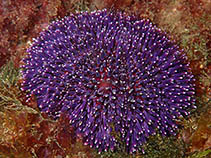Sphaerechinus granularis (Lamarck, 1816)
| Native range | All suitable habitat | Point map | Year 2050 |

|
| This map was computer-generated and has not yet been reviewed. |
| Sphaerechinus granularis AquaMaps Data sources: GBIF OBIS |
Classification / Names Common names | Synonyms | CoL | ITIS | WoRMS
Echinoidea | Camarodonta | Toxopneustidae
Environment: milieu / climate zone / depth range / distribution range Ecology
Benthic; depth range 2 - 130 m (Ref. 85345). Temperate; 53°N - 13°N, 32°W - 37°E
Distribution Countries | FAO areas | Ecosystems | Occurrences | Introductions
Eastern Atlantic and the Mediterranean Sea: from Ireland to the English Channel (French coast) to Spain, into the entire Mediterranean, to Morocco and Gulf of Guinea, including the islands of Azores, Madeira, Canary and Cape Verde. Temperate and subtropical.
Length at first maturity / Size / Weight / Age
Maturity: Lm ? range ? - ? cm
Maximum depth from Ref. 106595. Intertidal (Ref. 106595) to sublittoral (Ref. 106593). Found on rocky shores (Refs. 106372, 106591, 106593, 106597). Also on grounds consisting of gravel encrusted with calcareous red algae (Ref. 106597). Herbivorous grazer (Ref. 106997). Grazes on encrusting coralline algae on rocks, on dead Posidonia oceanica leaves and their epiphytes, and on the rhizomes and roots of the seagrass when accessible (Ref. 106595). Scrapes the external part of rhizomes and consumes the roots entirely (Ref. 106997). Bioeroder since it feeds on any coralline substrate (Ref. 106598).
Life cycle and mating behavior Maturity | Reproduction | Spawning | Eggs | Fecundity | Larvae
Members of the class Echinoidea are gonochoric. Fertilization is external. Brooding is common, eggs are held either on the peristome, around the periproct or deep into the concavities on the petaloids. Life cycle: Embryos develop into planktotrophic larvae (echinoplateus) and live for several months before they sink to the bottom using their tube feet to adhere on the ground where they metamorphose into young urchins.
Main reference
References | Coordinator | Collaborators
Gaspar, M.B., M.D. Dias, A. Campos, C.C. Monteiro, M.N. Santos, A. Chicharo and L. Chicharo. 2001. (Ref. 2714)
IUCN Red List Status (Ref. 130435)
CITES status (Ref. 108899)
Not Evaluated
CMS (Ref. 116361)
Not Evaluated
Threat to humans
Human uses
| FishSource |
Tools
More information
Age/Size
Growth
Length-weight
Length-length
Morphology
Larvae
Abundance
Growth
Length-weight
Length-length
Morphology
Larvae
Abundance
Internet sources
BHL | BOLD Systems | CISTI | DiscoverLife | FAO(Publication : search) | Fishipedia | GenBank (genome, nucleotide) | GloBI | Gomexsi | Google Books | Google Scholar | Google | PubMed | Tree of Life | Wikipedia (Go, Search) | Zoological Record
Estimates based on models
Preferred temperature
(Ref. 115969): 14.1 - 21.3, mean 18.2 (based on 280 cells).
Price category
(Ref. 80766):
Unknown.



